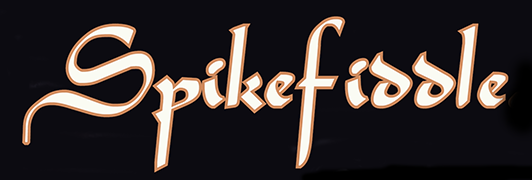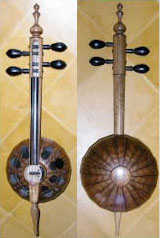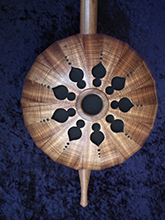Background and Development
Here are some of the people and instruments who were important in the tarhu's development.
Erhan Alptekin; master yayli tanbur player, singer and composer.
I saw Erhan perform in 1976, and as a result changed direction completely - started making spikefiddles, began learning Turkish music. No single person is more central to the creation of the tarhu than Erhan (well.........except for me, that is).
Habil Aliev; greatest exponent of Azerbaijani Classical Music of last century, master of the kamancha.
Habil had a depth and range in his use of tone colour that stands above all other players of bowed instruments I know of, East or West. I heard a recording of him in 1995 just when the tarhu was coming into existence. Habil's playing helped me to form an image of what bowed sound could be , and this has guided the development of the small tarhus ever since (kamancheh tarhu, shah kaman and tarhui).
Ross Daly; multi instrumentalist, composer and master within several traditions from the Near and Middle East.
It was Ross's interest and ongoing support that encouraged me to start taking orders for tarhus, and to change the focus of my instrument making work towards making only tarhus. The Lyra Tarhu and later the Nak Tarhu came into existence as a direct result of collaboration with Ross.
Greg Smallman: classical guitar maker without equal (his guitars played by John Williams since the early Eighties).
Greg and I both started instrument making in the early Seventies, and we collaborated continually in the early years before eventually becoming partners in guitar making in the late Seventies. Some of the experimental work we did was on the use of wooden cones in plucked instruments, which sowed the seeds for the use of wooden cones in the tarhu some 20 years later.
Harry Partch; Just Intonation exponent, theorist, composer and instrument maker.
Partch's wonderful sculptural instruments pointed me towards developing new instruments when I first heard them in 1974 (the year he died). His work in Just intonation was very influential for me, and has been part of everything I have done since discovering it. One of the Turkish tanbur's initial attractions for me was it's suitability for exploring just intonation - the longneck tarhu has facilitated a further step in that direction.
The Turkish tanbur is a long-neck bowed instrument with 6 strings arranged in pairs, with only the highest pair being played with the bow. It provides the reference pitch for Turkish Classical music with it's 27 tones-to-the-octave fretting system. I had been experimenting with bowed banjo and just-intonation prior to hearing Tanbur, so was very receptive. The tanbur is configured in such a way that only the highest string can be bowed.
The Erhu is the classic 2 string spikefiddle of the Far East, originating in China. The erhu is one of the only bowed instruments in which the addition of a sound-post destroys sound quality rather than enhances it. The bowing angle in the Erhu renders the use of a sound-post superfluous. Experiencing this aspect of the erhu provided invaluable perspectives for developing the tarhu.
The Duduk is a double-reed wind instrument found throughout the Near East, Middle East and Central Asia. The duduk has been a much more important source of inspiration for the sound of the small tarhus than any stringed instrument (except for Habil Aliev's kamancha). The duduk is capable of producing a most wonderful range of vowel-like tone colours
The kamancheh from Persia and Azerbaijan has been one of my favourite instrumental design forms since before I started instrument making. Aspects of the kamancheh's form where important in developing a body for the tarhu concept to inhabit, and became central once I started making small tarhus.
The North Indian Vina , or Bin, is the most quintessentially Indian of that country's many stringed instruments. It is another of my all-time favourite forms, and the work I did on Bin over a period of several years in the late seventies/early eighties contributed significantly to the tarhu's final design.
The Double Bass - one of the few instruments that can be played at the highest professional level as either a plucked or bowed instrument. This dual aspect of the Bass was an inspiration for me to develop the Tarhu to be equally adept at bowing and plucking.
Perspectives gathered from these many sources gradually formed the desire for an instrument that possessed the greatest possible subtlety in tone colour variations, combined with strong projection. All indications were that this sensitivity and power could only be achieved using a very light-weight soundboard. The solution was provided by the use of a cone made from thin strips of wood, and experiments with bowed cones began in 1993.
In 1995 I brought all of my experimental work together into a new acoustic design, which has been in a process of continuing development since then. The present spherical body was developed in 1998, and has now been used making instruments in a variety of styles and sizes. These instruments have been directed towards any musicians from East or West who like to use a broad range of tone colours in their music.
Stages in the Tarhu’s Evolution.
Yayli Tanbur - 1984
This Tanbur is similar to the one I played from 1984 to 1995. It has been adapted a few steps from the traditional Turkish form - the body was redesigned to allow bowing of more than one string, and a sound-post was added within the body. It has three playing strings, and three sympathetic strings in a channel down the middle of the neck.
Erhu with rearranged neck position - 1992
I made several adapted erhus in 1992 while working on composer Judy Clingan's opera "Marco" (based on the travels of Marco Polo). I needed the erhu sound, but in a configuration that would allow the instruments to be played by violinists (fingers pressing strings onto a fingerboard, rather than fretting in mid-air, as on the erhu). These experimental erhus provided the opportunity for an up-close look at erhu acoustics, which turned out to be very productive.
Bowtar - 1993
Experimental Instrument with gourd resonator. Here the Erhu bow direction was maintained, but the neck and body rearranged to allow three playing strings, two of which could be bowed at the same time (normally not possible on the Erhu).
Cone-Erhu - 1994
Sculptural-study instrument using Erhu bow direction, this time with a lightweight fibreglass cone instead of a flat skin soundboard.
The Erhu-based instruments, while very interesting, all had a limitation imposed by the bowing direction – in order to be able to bow close to the bridge, the soundboard had to be very small. This limited the available pitch range considerably.
Tarhu Prototype -1995
Eventually, the desire to integrate the Tanbur and Erhu threads of research gave birth to the use of a larger cone and a new bridge design. While the Tarhu bridge/cone configuration does not include a sound-post as such, the bridge design performs the same function as a sound-post by transferring vibrations from one plane to another.
This instrument had 4 playing strings and 8 sympathetic strings in a channel down the middle of the neck.
Tarhui - 1998
This was the first Tarhu in which the current aesthetic ideas emerged. The Kamancheh and North Indian Vina influenced the initial form inherited from the Tanbur.
This is a small instrument, with the same vibrating-string length as a violin, and tuned around violin pitch range.
Tenor Tarhu - 1998
This was the first tarhu to use a spherical body made up of many strips of wood. The techniques involved came from lute-back construction, and I first applied them to the making of wooden spheres in 1978/9 when I was doing experimental work on the North Indian Vina
Long Neck Tarhus - 1999 > 2003
Over this time period many forms of neck and stringing arrangements where tried.
Left: Traditional Turkish Tanbur neck, with long string-length and 6 strings all on the fingerboard.
Centre: Shorter string length, 6 strings arranged as 3 playing strings, 3 sympathetics in a channel
Right: Finally accepting the original concept of 4 playing strings and 8 sympathetics in a channel.
KamanchehTarhu - 2001
The first kamancheh version of the tarhu - turned wooden body.
Soprano, Alto and Tenor Tarhus - 1998 > 2002
At this stage I was exploring the possibility of creating a family of tarhus that could all play together in a similar way to the violin family.
These instruments, and many others from the tarhu archives, were shown at an exhibition of experimental instruments at the Powerhouse Museum, Brisbane 2002
Lyra Tarhu - 2002
The lyra tarhu came into being in collaboration with Ross Daly, for whom this instrument was made. It is of a similar size to traditional lyra, with the same 3 playing strings. It has 9 sympathetic strings tuned with zither pins.
The lyra tarhu was replaced in 2006 by the larger Nak Tarhu
Kamancheh Tarhu with Sympathetic Strings - 2003
This form of kamancheh tarha was developed in collaboration with Kayhan Kalhor, and was the first of 2 instruments made for Kayhan. It had 4 playing strings and 7 sympathetic strings tuned on the bass side of the pegbox with harp pins.
The body was closer to traditional kamancheh shape than other tarhus.
Tarhu - 2003
This tarhu was made for Ross Daly, and was the first long neck tarhu that used a body made of 18 ribs.
Kamancheh Tarhu - 2004
This kamancheh tarhu (made for Habil Aliyev) was the first kamancheh tarhu to use a spherical body made of 18 ribs.
The kamancheh tarhu sound was developed in collaboration with Habil Aliyev when we were both staying in Crete.
Nak Tarhu - 2006
The Nak Tarhu developed out of the lyra tarhu after further collaboration with Ross Daly. The Nak Tarhu eventually replaced the lyra tarhu.
The head/neck design allows the sympathetic strings to be much longer, making them more effective. The number of playing strings was also extended from 3 to 5 strings. The body in the earlier versions was turned.
Ross Daly developed the stringing system for the nak tarhu, based on the unidirectional horse hair strings of Central Asia. Ross uses unidirectional nylon of various gauges.
Cellhu - 2007
A unique adaptation of tarhu concepts, made for the Israeli cellist Rali Margalit
Tarhui - 2007
At this point the Tarhui reached its current overall form as a fretless instrument tuned around viola pitch, with sympathetic strings. It still had a turned body at this stage.
Brass Tarhu - 2008
A range of brass tarhus were introduced in 2008 as a possible solution to providing a cheaper alternative to the bodies made from 18 wooden ribs.
The bodies were hand beaten using a concave mould with repeated heat treatments.
Discontinued in 2012. (oh, my aching shoulder!)
Shah Kaman - 2008
The ongoing collaboration with Kayhan Kalhor culminated in this design of Kamancheh Tarhu with Sympathetic Strings - Kayhan found such a name unwieldy, and called it Shah Kaman instead.
5 playing strings and 7 sympathetics, spherical body
Kamancha Tarhu - 2009
An alternative design for the holes in kamancha tarhu, introduced in 2009.
This instrument was made for Imamyar Hasanov.
Undachin Tarhu - 2011
Tarhu concepts made available to violin players. Like the Cellhu, a ridiculous amount of development work for a single instrument. Evidently one has to do such things to find where the boundaries of a concept lie. Working on the Cellhu and the Undachin Tarhu assisted me in defining the most essential tarhu characteristic as "a stringed instrument with an almost-spherical body housing a light-weight wooden cone". ...........or put another way, the concepts underlying the tarhu's design make the spikefiddle genus its natural home.
New Holes System - 2012
Providing a comparatively large area of soundholes in the back of the body was a design concept not predicted by most instrument-acoustics models, but has proven very successful in the smaller tarhus.
Tarhui - 2015
The Tarhui is finally brought up-to-date with other tarhu forms, with the use of a body made from 18 ribs. It is a mini version of the long neck tarhu, tuned around viola pitch with viola string-length, 4 playing strings and 8 sympathetic strings in a channel down the neck.


































